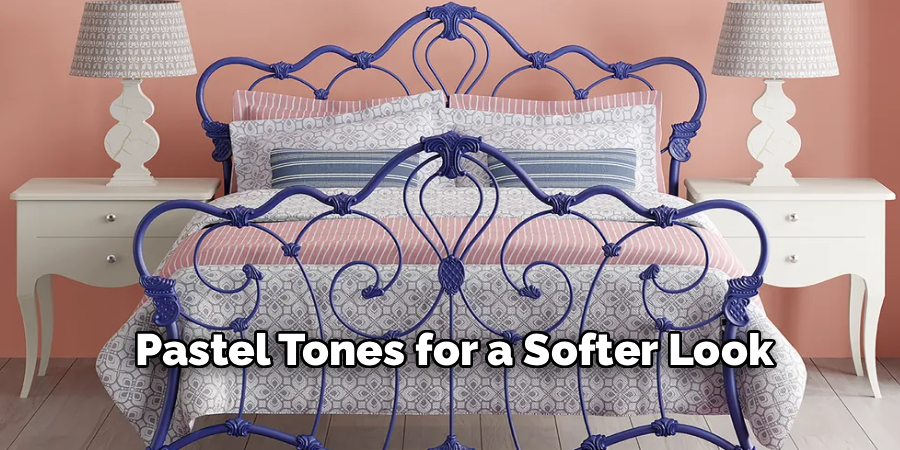A fresh coat of paint can completely transform the look of a room, especially when applied to furniture that’s been neglected over time. Learning how to paint a metal bed frame is a simple, budget-friendly project that breathes new life into an old or outdated piece. With just a few tools, some preparation, and a bit of patience, you can turn a rusty or dull frame into a sleek, modern, or vintage showpiece that perfectly fits your bedroom style.
Whether you’re updating the color to match your décor or restoring a thrifted find, painting metal gives you both creative freedom and long-lasting results. In this guide, you’ll discover exactly how to prep, paint, and finish your bed frame for a flawless, durable look that can last for years.

The Benefits of Painting Your Metal Bed Frame
Repainting a metal bed frame is one of the easiest DIY projects with big rewards. The most obvious benefit is cost savings—updating your existing frame is far cheaper than replacing it. With a few cans of paint and a free afternoon, you can achieve a professional-level makeover for a fraction of the price.
This project also supports sustainability by reusing what you already own. Instead of sending furniture to the landfill, you’re giving it a second life. Painting also protects the metal from corrosion, scratches, and wear, making the frame more durable.
On top of that, you get total creative control. You can choose any color or finish—matte black for an industrial vibe, antique gold for elegance, or pastel tones for a softer look. Each brushstroke adds character, and the final result feels deeply personal. Beyond aesthetics, this process provides a satisfying sense of accomplishment that comes from creating something beautiful with your own hands.

Tools and Materials You’ll Need
Before starting, gather everything to make your painting project smooth and stress-free.
- Cleaning Supplies: Mild soap or degreaser, water, clean cloths, and towels
- Safety Gear: Gloves, mask, and protective glasses
- Sanding Tools: Medium and fine-grit sandpaper or a wire brush for rust removal
- Drop Cloths or Plastic Sheets: To cover your workspace and catch overspray
- Painter’s Tape: For masking off non-paint areas
- Metal Primer: Rust-inhibiting primer made for metal surfaces
- Paint: Spray or brush-on paint formulated for metal furniture
- Brushes or Paint Sprayer: Depending on your preferred method
- Clear Sealant (Optional): Acrylic or enamel topcoat for extra protection
- Wrenches or Screwdrivers: For disassembling and reassembling the frame
Having all materials ready will save time and help you maintain a clean, efficient workflow.

Step-by-Step Guide: How to Paint a Metal Bed Frame
Step 1: Disassemble the Bed Frame
Start by taking apart the bed frame into separate sections—the headboard, footboard, and side rails. This makes each piece easier to handle and ensures even coverage. Keep screws and bolts in a small labeled container to avoid misplacing them. Move the disassembled parts to a well-ventilated area like a garage, patio, or driveway, and lay down a drop cloth to protect the floor.
Cleaning and preparation are key. Wipe away dust and grime using a mixture of warm water and mild soap or degreaser. Any dirt left behind can interfere with the primer’s adhesion. Rinse thoroughly and dry completely with a towel. Proper cleaning ensures that paint sticks evenly, setting the stage for a smooth, professional-looking finish.
Step 2: Sand the Metal Surface
Once the frame is clean, it’s time to sand. Sanding removes old paint, rust, and rough spots while providing texture for the new paint to adhere properly. Use medium-grit sandpaper (around 120–180 grit) to scuff the surface lightly. Focus on corners, curves, and intricate details where rust tends to accumulate.
For heavily rusted areas, switch to a wire brush or coarse-grit sandpaper. You don’t need to strip the metal down to its bare surface—just eliminate loose paint and create a consistent texture. After sanding, wipe the entire frame with a damp cloth to remove all dust particles. Allow it to dry fully before applying primer. This careful preparation step determines how long your new paint job will last.
Step 3: Apply a Metal Primer
Primer is what ensures your paint sticks firmly and resists rust over time. Choose a primer specifically labeled for metal, ideally one with rust-inhibiting properties. Shake or stir it well before application.
If using a spray primer, hold the can about 10 inches from the surface and spray in light, even strokes. Avoid concentrating too long in one area to prevent drips. If brushing, use long, smooth strokes and apply thin coats. The primer will provide a uniform base, helping your chosen paint color appear more vibrant.
Let the primer dry completely—typically for a few hours or as instructed on the label. Skipping this step or rushing the drying time may lead to peeling paint or uneven coverage later.
Step 4: Apply the First Coat of Paint
Now comes the fun part: adding color. Spray paint is ideal for metal because it offers even coverage and reaches tricky areas easily. Shake the can well and spray from about 8–12 inches away in sweeping, side-to-side motions. Keep the coats thin; multiple light layers are far better than one heavy coat.

If you’re using a brush-on paint, work in smooth, even strokes following the metal’s natural lines. Be sure to cover corners and joints thoroughly. Don’t worry if the first coat looks slightly uneven—it’s only the foundation. The goal here is consistency and avoiding drips.
Allow this coat to dry completely before moving to the next step. Proper drying helps the color set firmly and prevents smudges.
Step 5: Apply the Second Coat
Once the first coat has cured, inspect the frame for imperfections or thin spots. Lightly sand any rough patches with fine-grit sandpaper (around 220 grit) to smooth out the surface. Wipe clean with a soft cloth.
Then apply the second coat in the same controlled manner—thin, even layers. This coat deepens the color and ensures full, uniform coverage. Depending on the paint type and your color choice, you might need a third coat, especially for lighter shades.
Take your time and let each layer dry according to the manufacturer’s recommendations. Patience here will reward you with a flawless, durable finish that looks professionally done.
Step 6 (Optional): Apply a Protective Sealant
While not mandatory, adding a clear topcoat can significantly enhance durability. It acts as a shield against scratches, moisture, and fading. A spray-on acrylic or enamel sealant works best for metal surfaces.
Apply it in thin, even layers just as you did with the paint. Choose your preferred finish—matte, satin, or glossy—to match your desired aesthetic. Allow the sealant to cure fully, which may take several days. Though optional, this step adds a layer of protection that extends the life of your paint job and keeps the bed frame looking brand new for years.
Step 7: Allow the Paint to Cure and Reassemble
Even after the paint feels dry to the touch, it needs time to cure completely. This process hardens the paint and ensures it can withstand regular use. Depending on temperature and humidity, curing can take 24 hours to several days.
Once cured, carefully reassemble the frame using your stored screws and bolts. Be gentle to avoid scratching the fresh paint. When tightened, cover metal-on-metal contact points with a small piece of cloth or felt to protect the new finish.
After reassembly, step back and admire your handiwork—a completely renewed piece that adds charm and style to your bedroom.
Customization Tips
Once you’ve mastered the basics, have fun experimenting with creative touches. For example:
- Use painter’s tape to create two-tone color schemes or striped patterns.
- Try metallic paints like gold, bronze, or silver for a glamorous feel.
- For a rustic or shabby chic look, lightly sand the edges after painting to reveal bits of the metal beneath.
- Add stenciled designs or decals for a custom flair.
These simple adjustments can make your bed frame truly unique and reflective of your personality.

Common Mistakes to Avoid
- Skipping Surface Prep: Paint won’t adhere to dirty or glossy metal. Always clean and sand first.
- Applying Thick Coats: This causes drips and uneven texture. Thin, multiple layers are better.
- Ignoring Drying Times: Rushing between coats leads to tacky, easily damaged paint.
- Painting in Poor Ventilation: Always work in a space with fresh airflow to avoid fumes and debris contamination.
- Skipping Primer: This is one of the biggest reasons paint peels early—never skip the priming stage.
Avoiding these mistakes guarantees a smooth, professional, and long-lasting finish.
Frequently Asked Questions
1. What kind of paint works best on a metal bed frame?
Opt for paint specifically made for metal surfaces. Spray paints labeled for metal provide the easiest and most even coverage. Alternatively, acrylic or oil-based enamel paints can be brushed on for durable results. Always pair with a compatible primer for maximum adhesion and rust resistance.
2. Can I paint a rusty metal bed frame?
Yes, but you must first remove loose rust using sandpaper or a wire brush. Once cleaned, apply a rust-inhibiting or rust-converting primer to neutralize remaining corrosion. Then proceed with painting. This process ensures the new coat lasts without bubbling or flaking.
3. Is it better to spray paint or brush paint a metal frame?
Both methods work, but spray paint offers smoother, more consistent coverage, especially for intricate details. Brush painting provides more control and is better for touch-ups. Your choice depends on the frame’s design and your comfort level.
4. How long should I wait before using the bed after painting?
While the surface may feel dry after a few hours, it’s best to wait at least 24–48 hours before reassembling. Full curing—where the paint reaches its final hardness—may take up to a week. Waiting ensures your finish won’t scratch or peel during use.
5. Do I need a topcoat over the paint?
A topcoat isn’t required but highly recommended for added protection. It seals the paint against moisture and prevents fading or chipping. Choose a clear acrylic or enamel finish that complements your paint sheen (matte, satin, or glossy).

Conclusion
Completing the project of how to paint a metal bed frame is one of the most rewarding DIY transformations you can do for your bedroom. With just a few supplies and some focused effort, you can turn a dull or rusted piece into a stylish centerpiece that looks brand new.
Remember these essentials for success:
- Always clean and sand before painting.
- Use a high-quality primer made for metal.
- Apply multiple thin coats, letting each dry fully.
- Optional: Seal for extra durability.
Your craftsmanship will shine every time you walk into the room and admire your revitalized bed frame. With patience and creativity, you’ve not only upgraded your furniture—you’ve created a piece that reflects your unique style and skill.

About
Emmett Finn is a distinguished figure in the world of Diy design, with a decade of expertise creating innovative and sustainable Diy solutions. His professional focus lies in merging traditional craftsmanship with modern manufacturing techniques, fostering designs that are both practical and environmentally conscious. As the author of diy, Emmett Finn delves into the art and science of furniture-making, inspiring artisans and industry professionals alike.
Education RMIT University
(Melbourne, Australia) Associate Degree in Design (Emmett Finn) Focus on sustainable design, industry-driven projects, and practical craftsmanship. Gained hands-on experience with traditional and digital manufacturing tools, such as CAD and CNC software.
Nottingham Trent University
(United Kingdom) Bachelor’s in diyfastly.com and Product Design (Honors) Specialized in product design with a focus on blending creativity with production techniques. Participated in industry projects, working with companies like John Lewis and Vitsoe to gain real-world insights.
Publications and Impact
In diy, Emmett Finn his insights on indoor design processes, materials, and strategies for efficient production. His writing bridges the gap between artisan knowledge and modern industry needs, making it a must-read for both budding designers and seasoned professionals.
